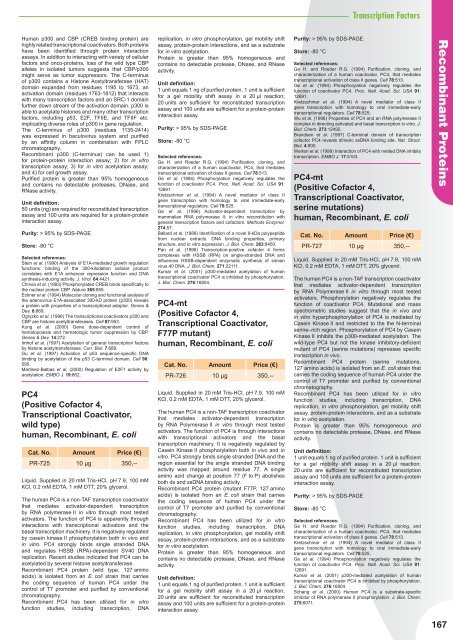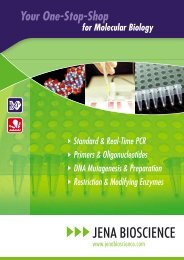Nucleotide Analogs - Jena Bioscience
Nucleotide Analogs - Jena Bioscience
Nucleotide Analogs - Jena Bioscience
Create successful ePaper yourself
Turn your PDF publications into a flip-book with our unique Google optimized e-Paper software.
Human p300 and CBP (CREB binding protein) are<br />
highly related transcriptional coactivators. Both proteins<br />
have been identifi ed through protein interaction<br />
assays. In addition to interacting with variety of cellular<br />
factors and onco-proteins, loss of the wild type CBP<br />
alleles in isolated tumors suggests that CBP/p300<br />
might serve as tumor suppressors. The C-terminus<br />
of p300 contains a Histone Acetyltransferase (HAT)<br />
domain expanded from residues 1195 to 1673, an<br />
activation domain (residues 1763-1812) that interacts<br />
with many transcription factors and an SRC-1 domain<br />
further down stream of the activation domain. p300 is<br />
able to acetylate histones and many other transcription<br />
factors, including p53, E2F, TFIIE, and TFIIF etc.<br />
implicating diverse roles of p300 in gene regulation.<br />
The C-terminus of p300 (residues 1135-2414)<br />
was expressed in baculovirus system and purifi ed<br />
by an affi nity column in combination with FPLC<br />
chromatography.<br />
Recombinant p300 (C-terminus) can be used 1)<br />
for protein-protein interaction assay; 2) for in vitro<br />
transcription assay; 3) for in vitro acetylation assay;<br />
and 4) for cell growth assay.<br />
Purifi ed protein is greater than 95% homogeneous<br />
and contains no detectable proteases, DNase, and<br />
RNase activity.<br />
Unit defi nition:<br />
50 units (ng) are required for reconstituted transcription<br />
assay and 100 units are required for a protein-protein<br />
interaction assay.<br />
Purity: > 95% by SDS-PAGE.<br />
Store: -80 °C<br />
Selected references:<br />
Stein et al. (1990) Analysis of E1A-mediated growth regulation<br />
functions: binding of the 300-kilodalton cellular product<br />
correlates with E1A enhancer repression function and DNA<br />
synthesis-inducing activity. J. Virol. 64:4421.<br />
Chrivia et al. (1993) Phosphorylated CREB binds specifi cally to<br />
the nuclear protein CBP. Nature 365:855.<br />
Eckner et al. (1994) Molecular cloning and functional analysis of<br />
the adenovirus E1A-associated 300-kD protein (p300) reveals<br />
a protein with properties of a transcriptional adaptor. Genes &<br />
Dev. 8:869.<br />
Ogryzko et al. (1996) The transcriptional coactivators p300 and<br />
CBP are histone acetyltransferases. Cell 87:953.<br />
Kung et al. (2000) Gene dose-dependent control of<br />
hematopoiesis and hematologic tumor suppression by CBP.<br />
Genes & Dev. 14:272.<br />
Imhof et al. (1997) Acetylation of general transcription factors<br />
by histone acetyltransferases. Curr. Biol. 7:689.<br />
Gu et al. (1997) Activation of p53 sequence-specifi c DNA<br />
binding by acetylation of the p53 C-terminal domain. Cell 90:<br />
595.<br />
Martinez-Balbas et al. (2000) Regulation of E2F1 activity by<br />
acetylation. EMBO J. 19:662.<br />
PC4<br />
(Positive Cofactor 4,<br />
Transcriptional Coactivator,<br />
wild type)<br />
human, Recombinant, E. coli<br />
Cat. No. Amount Price (€)<br />
PR-725 10 µg 350,--<br />
Liquid. Supplied in 20 mM Tris-HCl, pH 7.9, 100 mM<br />
KCl, 0.2 mM EDTA, 1 mM DTT, 20% glycerol.<br />
The human PC4 is a non-TAF transcription coactivator<br />
that mediates activator-dependent transcription<br />
by RNA polymerase II in vitro through most tested<br />
activators. The function of PC4 is apparently through<br />
interactions with transcriptional activators and the<br />
basal transcription machinery. It is negatively regulated<br />
by casein kinase II phosphorylation both in vivo and<br />
in vitro. PC4 strongly binds single stranded DNA<br />
and regulates HSSB (RPA)-dependent SV40 DNA<br />
replication. Recent studies indicated that PC4 can be<br />
acetylated by several histone acetyltransferase.<br />
Recombinant PC4 protein (wild type, 127 amino<br />
acids) is isolated from an E. coli strain that carries<br />
the coding sequence of human PC4 under the<br />
control of T7 promoter and purifi ed by conventional<br />
chromatography.<br />
Recombinant PC4 has been utilized for in vitro<br />
function studies, including transcription, DNA<br />
replication, in vitro phosphorylation, gel mobility shift<br />
assay, protein-protein interactions, and as a substrate<br />
for in vitro acetylation.<br />
Protein is greater than 95% homogeneous and<br />
contains no detectable protease, DNase, and RNase<br />
activity.<br />
Unit defi nition:<br />
1 unit equals 1 ng of purifi ed protein. 1 unit is suffi cient<br />
for a gel mobility shift assay in a 20 µl reaction;<br />
20 units are suffi cient for reconstituted transcription<br />
assay and 100 units are suffi cient for a protein-protein<br />
interaction assay.<br />
Purity: > 95% by SDS-PAGE.<br />
Store: -80 °C<br />
Selected references:<br />
Ge H. and Roeder R.G. (1994) Purifi cation, cloning, and<br />
characterization of a human coactivator, PC4, that mediates<br />
transcriptional activation of class II genes. Cell 78:513.<br />
Ge et al. (1994) Phosphorylation negatively regulates the<br />
function of coactivator PC4. Proc. Natl. Acad. Sci. USA 91:<br />
12691.<br />
Kretzschmar et al. (1994) A novel mediator of class II<br />
gene transcription with homology to viral immediate-early<br />
transcriptional regulators. Cell 78:525.<br />
Ge et al. (1996) Activator-dependent transcription by<br />
mammalian RNA polymerase II: in vitro reconstitution with<br />
general transcription factors and cofactors. Methods Enzymol.<br />
274:57.<br />
Ballard et al. (1988) Identifi cation of a novel 9-kDa polypeptide<br />
from nuclear extracts. DNA binding properties, primary<br />
structure, and in vitro expression. J. Biol. Chem. 263:8450.<br />
Pan et al. (1996) Transcription-positive cofactor 4 forms<br />
complexes with HSSB (RPA) on single-stranded DNA and<br />
infl uences HSSB-dependent enzymatic synthesis of simian<br />
virus 40 DNA. J. Biol. Chem. 271:22111.<br />
Kumar et al. (2001) p300-mediated acetylation of human<br />
transcriptional coactivator PC4 is inhibited by phosphorylation.<br />
J. Biol. Chem. 276:16804.<br />
PC4-mt<br />
(Positive Cofactor 4,<br />
Transcriptional Coactivator,<br />
F77P mutant)<br />
human, Recombinant, E. coli<br />
Cat. No. Amount Price (€)<br />
PR-726 10 µg 350,--<br />
Liquid. Supplied in 20 mM Tris-HCl, pH 7.9, 100 mM<br />
KCl, 0.2 mM EDTA, 1 mM DTT, 20% glycerol.<br />
The human PC4 is a non-TAF transcription coactivator<br />
that mediates activator-dependent transcription<br />
by RNA Polymerase II in vitro through most tested<br />
activators. The function of PC4 is through interactions<br />
with transcriptional activators and the basal<br />
transcription machinery. It is negatively regulated by<br />
Casein Kinase II phosphorylation both in vivo and in<br />
vitro. PC4 strongly binds single stranded DNA and the<br />
region essential for the single stranded DNA binding<br />
activity was mapped around residue 77. A single<br />
amino acid change at position 77 (F to P) abolishes<br />
both ds and ssDNA binding activity.<br />
Recombinant PC4 protein (mutant F77P, 127 amino<br />
acids) is isolated from an E. coli strain that carries<br />
the coding sequence of human PC4 under the<br />
control of T7 promoter and purifi ed by conventional<br />
chromatography.<br />
Recombinant PC4 has been utilized for in vitro<br />
function studies, including transcription, DNA<br />
replication, in vitro phosphorylation, gel mobility shift<br />
assay, protein-protein interactions, and as a substrate<br />
for in vitro acetylation.<br />
Protein is greater than 95% homogeneous and<br />
contains no detectable protease, DNase, and RNase<br />
activity.<br />
Unit defi nition:<br />
1 unit equals 1 ng of purifi ed protein. 1 unit is suffi cient<br />
for a gel mobility shift assay in a 20 µl reaction;<br />
20 units are suffi cient for reconstituted transcription<br />
assay and 100 units are suffi cient for a protein-protein<br />
interaction assay.<br />
Purity: > 95% by SDS-PAGE.<br />
Store: -80 °C<br />
Transcription Factors<br />
Selected references:<br />
Ge H. and Roeder R.G. (1994) Purifi cation, cloning, and<br />
characterization of a human coactivator, PC4, that mediates<br />
transcriptional activation of class II genes. Cell 78:513.<br />
Ge et al. (1994) Phosphorylation negatively regulates the<br />
function of coactivator PC4. Proc. Natl. Acad. Sci. USA 91:<br />
12691.<br />
Kretzschmar et al. (1994) A novel mediator of class II<br />
gene transcription with homology to viral immediate-early<br />
transcriptional regulators. Cell 78:525.<br />
Wu et al. (1998) Properties of PC4 and an RNA polymerase II<br />
complex in directing activated and basal transcription in vitro. J.<br />
Biol. Chem. 273:12492.<br />
Brandsen et al. (1997) C-terminal domain of transcription<br />
cofactor PC4 reveals dimeric ssDNA binding site. Nat. Struct.<br />
Biol. 4:900.<br />
Werten et al. (1998) Interaction of PC4 with melted DNA inhibits<br />
transcription. EMBO J. 17:5103.<br />
PC4-mt<br />
(Positive Cofactor 4,<br />
Transcriptional Coactivator,<br />
serine mutations)<br />
human, Recombinant, E. coli<br />
Cat. No. Amount Price (€)<br />
PR-727 10 µg 350,--<br />
Liquid. Supplied in 20 mM Tris-HCl, pH 7.9, 100 mM<br />
KCl, 0.2 mM EDTA, 1 mM DTT, 20% glycerol.<br />
The human PC4 is a non-TAF transcription coactivator<br />
that mediates activator-dependent transcription<br />
by RNA Polymerase II in vitro through most tested<br />
activators. Phosphorylation negatively regulates the<br />
function of coactivator PC4. Mutational and mass<br />
spectrometric studies suggest that the in vivo and<br />
in vitro hyperphosphorylation of PC4 is mediated by<br />
Casein Kinase II and restricted to the the N-terminal<br />
serine–rich region. Phosphorylation of PC4 by Casein<br />
Kinase II inhibits the p300-mediated acetylation. The<br />
wild-type PC4 but not the kinase inhibitory-defi cient<br />
mutant of PC4 (serine mutations) represses specifi c<br />
transcription in vivo.<br />
Recombinant PC4 protein (serine mutations,<br />
127 amino acids) is isolated from an E. coli strain that<br />
carries the coding sequence of human PC4 under the<br />
control of T7 promoter and purifi ed by conventional<br />
chromatography.<br />
Recombinant PC4 has been utilized for in vitro<br />
function studies, including transcription, DNA<br />
replication, in vitro phosphorylation, gel mobility shift<br />
assay, protein-protein interactions, and as a substrate<br />
for in vitro acetylation.<br />
Protein is greater than 95% homogeneous and<br />
contains no detectable protease, DNase, and RNase<br />
activity.<br />
Unit defi nition:<br />
1 unit equals 1 ng of purifi ed protein. 1 unit is suffi cient<br />
for a gel mobility shift assay in a 20 µl reaction;<br />
20 units are suffi cient for reconstituted transcription<br />
assay and 100 units are suffi cient for a protein-protein<br />
interaction assay.<br />
Purity: > 95% by SDS-PAGE.<br />
Store: -80 °C<br />
Selected references:<br />
Ge H. and Roeder R.G. (1994) Purifi cation, cloning, and<br />
characterization of a human coactivator, PC4, that mediates<br />
transcriptional activation of class II genes. Cell 78:513.<br />
Kretzschmar et al. (1994) A novel mediator of class II<br />
gene transcription with homology to viral immediate-early<br />
transcriptional regulators. Cell 78:525.<br />
Ge et al. (1994) Phosphorylation negatively regulates the<br />
function of coactivator PC4. Proc. Natl. Acad. Sci. USA 91:<br />
12691.<br />
Kumar et al. (2001) p300-mediated acetylation of human<br />
transcriptional coactivator PC4 is inhibited by phosphorylation.<br />
J. Biol. Chem. 276:16804.<br />
Schang et al. (2000) Human PC4 is a substrate-specifi c<br />
inhibitor of RNA polymerase II phosphorylation. J. Biol. Chem.<br />
275:6071.<br />
Recombinant Proteins<br />
167



